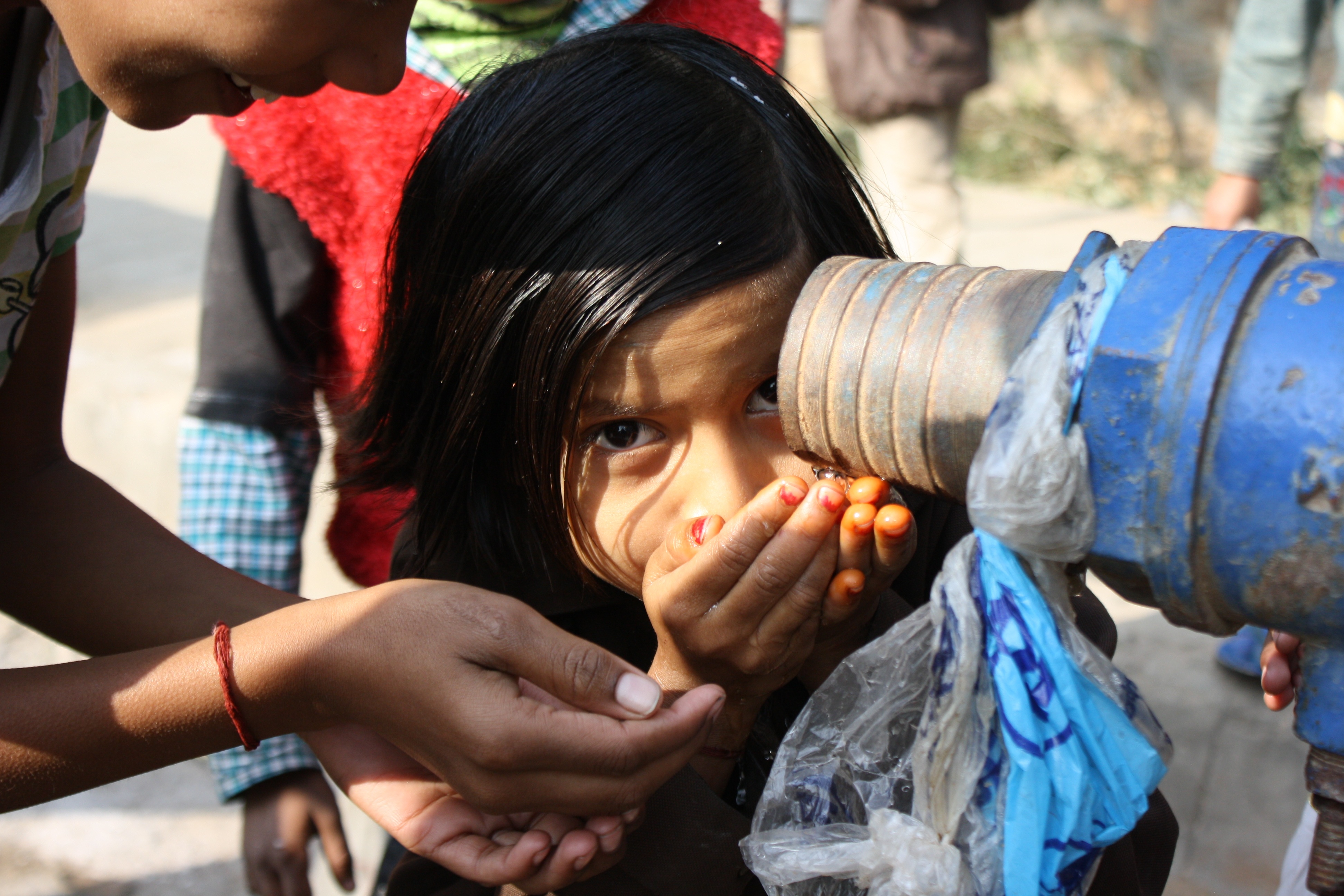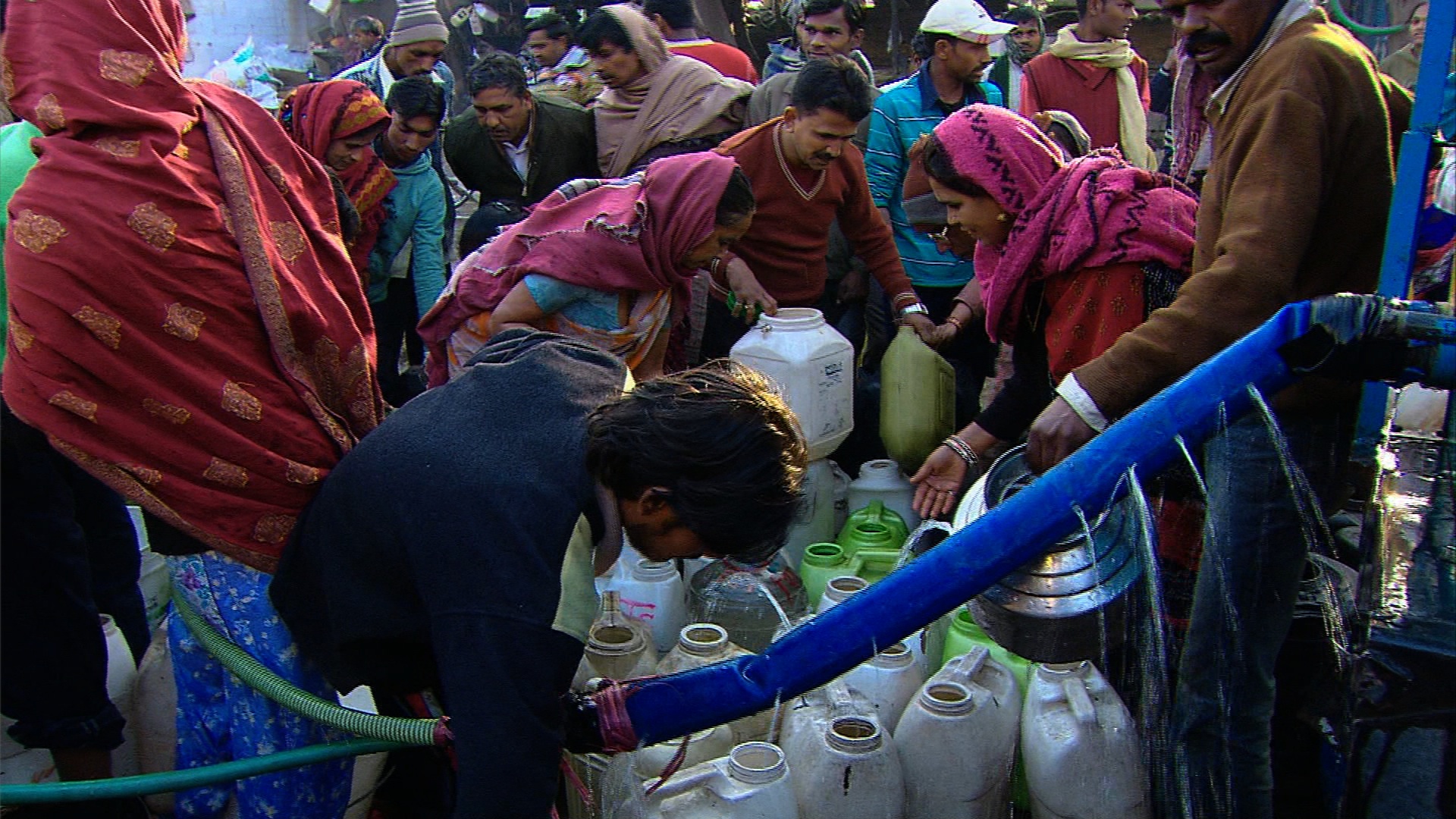
If there are water wars in the future, conservationist Jyothi Sharma thinks they'll happen just outside her apartment in an upper middle class enclave in Delhi's Vasant Kunj neighborhood. Right across her street is a sprawling slum, an illegal settlement but quite rational. These neighbors are economic migrants from rural areas who come to find work as domestics across the street or as daily laborers in India's booming—and almost entirely urban—new economy. The annual influx adds anywhere from 500,000 to 700,000 news residents to India's capital which, at 16 million inhabitants is already well past its carrying capacity.
"Only 27 percent of this city is a planned city," says Sharma. "You cannot stop them coming because it's the only place they can get some livelihood."
Since the Vasant Kunj slum is illegal, the government cannot install permanent infrastructure, such as a community water tap. Instead, the municipality dispatches a large water tanker each day. The exact time it arrives is anyone's guess. When it does, there's a mad dash as people driven by frustration and even thirst converge on the truck, elbows before siphons. In a short time, hundreds of jerry cans and buckets are filled, their owners finally allowed to resume their lives.
"The children lose an average of one day of school and adults about four hours of productive work time just to provide for their water and sanitation needs," says Sharma, who runs a non-government group called Force.
Back on her side of the street, neighbors are hardly free of water worries but can buy their way out of long lines and waits. The municipal water supply to their apartment buildings comes on for about 45 minutes each day, a trickle so anemic that residents use electric pumps to suck it into holding tanks and later to rooftop reservoirs.
Sharma says the Indian capital's water woes could be largely eased by simple practices like rainwater collection systems and recycling. Instead, fresh water is now piped in from dams more than 200 miles away.
It all betrays a widespread indifference at all policy levels toward this vital, ever-dwindling resource. This is particularly true in agriculture, which consumes eighty percent of the fresh water, says Ashok Jaitly, a water expert at The Environmental Research Institute (TERI) in Delhi. Across the plains of India's breadbasket state of Punjab, groundwater is pumped up and gushes over cotton, rice and other thirsty crops. At least half of it is wasted; draining aquifers to a point that Jaitly says will threaten the nation's food security in a few years. But for now, farmers, an electoral force in Indian politics, pay nothing for water or electricity.
"You have the politics of populism, which encourages inefficient farm management and water utilization," Jaitly adds. "It's a very emotive and political issue."
So is the issue of population.
"In India we don't have social security for elderly people, so only they have to rely on children, says Ashish Bose, a leading demographer and author of a new book, Headcount. Coercive attempts to enforce family planning in the 1970s led to the downfall of Indira Gandhi's government, Bose says, and no government dares mention the subject.
The best way to insure a smaller family is to increase its economic security, he adds. "Development is the best contraceptive."
Ironically, India has enjoyed years of healthy economic growth but activist Jyothi Sharma says absent a comprehensive new approaches to conserving water it makes the water war scenario more plausible since all development does is spike more demand for less water. The day these tankers stop coming, she says, her far more numerous neighbors from across the street will come after the storage tanks that provides the middle class some precarious protection from shortages.
"Populations are dense, resources are dwindling, aspirations are high. This is where the conflict will be."
By most authoritative projections, India's population will begin to stabilize in 2050, at a world-leading 1.6 billion.
To learn more:
-Indian government's Population Commission website
http://populationcommission.nic.in/
-India Population Map
http://www.mapsofindia.com/maps/india/population.htm
India's Water Supply and Demand from 2025-2050
http://www.iwmi.cgiar.org/Publications/Other/PDF/NRLP%20Proceeding-2%20Paper%202.pdf
-Population Foundation of India
http://www.popfound.org/index.htm
Imminent Water Crisis in India
http://www.arlingtoninstitute.org/wbp/global-water-crisis/606
India Water Report, Water.org
http://water.org/projects/india/
Water Resources and Climate Change: An Indian Perspective
http://www.ias.ac.in/currsci/jun252006/1610.pdf
Underground Water Development in India – Trends, Crops, Gupta
http://www.gopio.net/india_development/Water_Study_NU_2005.pdf
Resources/Journalism:
Often Parched, India Struggles to Tap The Monsoon, Sengupta, NYT
http://www.nytimes.com/2006/10/01/world/asia/01india.html
In Teeming India, Water Crisis Means Dry Pipes and Foul Sludge, Sengupta, NYT
http://www.nytimes.com/2006/09/29/world/asia/29water.html
India Digs Deeper, but Wells Are Drying Up, Sengupta, NYT
http://www.nytimes.com/2006/09/30/world/asia/30water2.html
As wealth rises in India, so do private towns
http://www.csmonitor.com/World/Asia-South-Central/2010/0716/As-wealth-rises-in-India-so-do-private-towns
Water Wars Erupt in India as Drought Threatens Population, Natural News
http://www.naturalnews.com/027490_water_wars_India.html
The State of Slums in India, Water Aid
http://www.wateraid.org/india/what_we_do/7518.asp
World Bank Approves Loans to India
http://economictimes.indiatimes.com/news/economy/finance/World-Bank-approves-two-projects-worth-372-mn-to-India/articleshow/6053539.cms
India Sounds Population Growth Alarm
http://www.redorbit.com/news/science/172055/india_sounds_population_growth_alarm/index.html
Water Dispute Increases India-Pakistan Tensions
http://www.nytimes.com/2010/07/21/world/asia/21kashmir.html?_r=1





